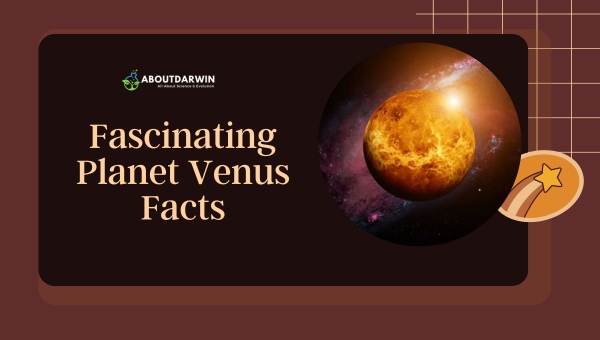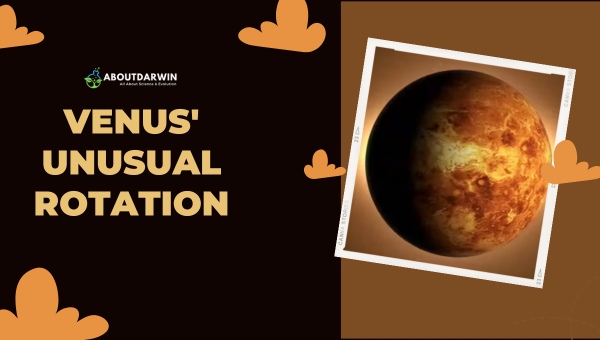Physical Address
304 North Cardinal St.
Dorchester Center, MA 02124
Regarding the cosmos, our neighboring planet Venus often takes a back seat as Mars most likely captures our imagination. However, Venus has many fascinating features that make it an intriguing celestial body. In this article, I’ll explore 20 facts about this beautiful planet, hoping to spark your interest in learning more.
Venus, the second planet from the sun, shines brightly in our sky and is named after the Roman goddess of love and beauty. Although it may seem charming from afar, it’s quite the opposite.
Venus boasts a harsh, corrosive atmosphere, scorching temperatures, and heavy crushing pressure on its surface. Despite these harsh conditions, the study of Venus yields vital information about Earth’s past and future climate and insights into the formation of terrestrial planets in general.
In this article, we’ll dive deep into the intriguing world of Venus, unraveling some of its most interesting facts that I’m sure you’ll find fascinating. From its retrograde rotation to its mysterious volcanic activity, allow me to take you on an adventure to one of the most enigmatic planets in our solar system.
Contents
Let’s look at some fascinating facts about Venus, the second planet from the sun. Often referred to as Earth’s twin, Venus shares many similarities with our planet but also hides many secrets waiting to be uncovered.

Venus is known for its extremely bright appearance, making it visible from Earth even during daylight hours. It’s the third brightest object in our sky, coming in right after the sun and moon. This brightness is caused by the planet’s dense atmosphere, which is made up mostly of carbon dioxide and sulfuric acid clouds that reflect sunlight.
Despite being similar in size to Earth, Venus is a torrid, bleak world. The surface temperature on Venus is boiling, averaging around 462°C (863°F), which is hotter than Mercury, the closest planet to the sun. I’ll lay out this surprising temperature hierarchy in a table for clarity:
| Planet | Surface Temperature |
|---|---|
| Mercury | 427°C (800°F) |
| Venus | 462°C (863°F) |
| Earth | 14°C (57°F) |
| Mars | -63°C (-81°F) |
This intense heat is mainly due to Venus’ thick atmosphere, which creates a “runaway greenhouse effect.” The atmosphere traps heat from the sun, causing the planet’s temperature to rise further.
Venus also has a peculiar rotation. While most planets rotate counterclockwise, Venus rotates clockwise in the opposite direction. Additionally, its process is very slow, taking approximately 243 Earth days to complete one full rotation, while its orbit around the sun takes only 225 Earth days. This makes a day on Venus longer than its year!
A few more captivating features of Venus include:
These striking facts reveal how much Venus, the bright, shining celestial neighbor to Earth, can hold surprises and challenge our understanding of the universe. As scientists continue to explore our solar system, we’ll likely uncover even more about this mysterious planet.
When it comes to Venus’ rotation, a few things stand out that make it quite different from Earth’s and other planets in our solar system. First of all, let’s consider its retrograde rotation. Unlike most planets, which rotate on their axes from west to east, Venus rotates from east to west. This unique phenomenon is called retrograde rotation, one peculiarity that makes Venus fascinating.

Another striking fact about Venus’s rotation is its slow speed. A day on Venus lasts much longer than a day on Earth, taking 243 Earth days to complete a full rotation. Surprisingly, that’s even longer than a year on Venus, which is only 225 Earth days. Imagine having a single day that lasts longer than an entire year!
Here’s a breakdown of Venus’ rotation characteristics in comparison to Earth’s:
| Venus | Earth | |
|---|---|---|
| Direction | East to West | West to East |
| Day Length | 243 Earth Days | 24 Hours |
| Year Length | 225 Earth Days | 365.24 Days |
The reasons behind Venus’ unusual rotation are still a subject of scientific debate. Some researchers believe it could have resulted from a catastrophic event such as a collision with a massive asteroid or a comet. This immense impact could have knocked Venus off its original rotation and set it on its current retrograde spin.
Another theory on Venus’ rotation stems from the planet’s thick atmosphere. It’s been suggested that the intense atmospheric pressure could lead to tidal bulges and friction between the atmosphere and the planet’s surface. Over time, this friction might have contributed to the slow rotation and the eventual retrograde motion of Venus.
In summary, Venus’ rotation is genuinely unique in our solar system, with its:
These intriguing features may have arisen from a catastrophic event or the planet’s interaction with its dense atmosphere. As scientists continue to investigate these mysteries, we’ll undoubtedly learn more about the captivating characteristics of our celestial neighbor, Venus.
I’ve always been fascinated by the volcanic landscape of Venus, and I’m excited to share some intriguing facts about it with you. Venus boasts the most volcanic features of any known celestial body in our solar system, leading scientists to conclude that it’s alive with volcanic activity. Though there’s still much to learn about this mysterious planet, let’s dive into what we already know.

Venus is covered in volcanic plains, which comprise approximately 85% of its surface. Numerous volcanoes of different sizes, ranging from small shield volcanoes to giant ones like Maat Mons.
This colossal formation stands at nearly 5 miles high, making it one of the tallest volcanic mountains in our solar system. In addition to Maat Mons, Venus is also home to hundreds of other large volcanic mountains.
It’s worth noting that not all of the volcanoes on Venus are like those found on Earth. Some of the features unique to Venus include:
Table showing the types of volcanoes on Venus:
| Type of Volcano | Number on Venus |
|---|---|
| Shield | Over 20,000 |
| Dome | Over 1,000 |
| Fissure | Unknown |
Based on the data collected, some scientists think that volcanic eruptions on Venus could be relatively recent – perhaps within the last few million years. To put that into perspective, Earth’s most recent large-scale volcanic eruption occurred over 75,000 years ago at Mount Toba in Indonesia. If this is true, it would mean that Venus is still geologically active, which could have significant implications for its atmosphere and climate.
The volcanic landscape of Venus is genuinely remarkable and presents unique features not found anywhere else in our solar system. As we continue to learn more about this enigmatic planet through future missions, I’m excited to see what discoveries await us in unveiling its volcanic secrets.
I’ve always been fascinated by Venus, our nearest planetary neighbor. While it may be the closest planet to Earth, Venus has some extreme temperatures that make it a vastly different place. Let’s look at these temperatures and the reasons behind them.
Venus is well-known for its incredibly high surface temperatures. It’s the hottest planet in our solar system. The average surface temperature on Venus reaches a scorching 467°C (872°F), which is hotter than Mercury, despite it being closer to the Sun. This intense heat is due to the strong greenhouse effect caused by Venus’ thick atmosphere.
The atmosphere of Venus is made up primarily of carbon dioxide (about 96.5%) and a small amount of nitrogen (about 3.5%). The carbon dioxide is responsible for trapping heat and raising the planet’s temperature.
Additionally, the atmosphere contains trace amounts of water vapor and sulfuric acid, which create the planet’s dense cloud cover. This cloud cover further contributes to the greenhouse effect, ensuring that heat is trapped and the temperatures stay high.
However, the extremes don’t stop there. Venus also experiences drastic temperature variations between its day and night sides. Despite the thick atmosphere, the temperature can still drop dramatically on the side facing away from the Sun, called the subsolar point. Here, temperatures can plunge to around -157°C (-250°F).
Here’s a simple table highlighting the temperature differences on Venus:
| Location | Temperature |
|---|---|
| Average | 467°C (872°F) |
| Subsolar Point | -157°C (-250°F) |
The extreme temperature variations on Venus can be attributed to several factors:
I hope this gives you an idea of just how intense the temperatures on Venus are. Despite being our neighbor in space, Venus remains a hostile and inhospitable world, much unlike our own Earth.
Read Top 10 Fascinating Facts About Uranus
Let me tell you about the fascinating atmosphere and cloud layers of Venus. One of the most striking aspects of Venus is its dense and toxic atmosphere, which consists predominantly of carbon dioxide and clouds made up of sulfuric acid droplets. These clouds cover the entire planet, making it impossible to see the surface using visible light.
Similar to Earth, the atmosphere of Venus has several layers. These are the troposphere, stratosphere, mesosphere, and thermosphere. However, the conditions on Venus are vastly different from those on Earth:
Venus has a unique feature called the “super-rotating” atmosphere. This phenomenon causes the atmosphere to spin around the planet incredibly fast – up to 60 times faster than the planet itself!
When it comes to cloud layers, Venus has a complex system that is divided into three distinct layers:
Temperature and pressure in Venus’ atmosphere vary greatly depending on the altitude. In the troposphere, the temperature can soar up to 480°C (900°F), while the pressure reaches a staggering 92 times that of Earth’s surface pressure – about the same as being 900 meters (3,000 feet) under the ocean on Earth.
On the other hand, the temperature decreases as we move upwards through the stratosphere and mesosphere, only to increase again in the thermosphere.
Its toxic composition, and extreme conditions make it a fascinating place to study and learn about.
I’ve always been fascinated by the planet Venus, our closest planetary neighbor. Over the years, multiple missions have been undertaken to explore and study this mysterious world. Allow me to share some interesting facts about these missions with you.
Venus has attracted the attention of space agencies across the globe, with various countries like the United States, the former Soviet Union, and European Space Agency playing significant roles. The Soviet Union’s Venera program, in particular, was a pioneering effort – they managed to land several probes on Venus’ surface.
In fact, the Venera 7 mission in 1970 became the first to successfully land a spacecraft on another planet. It’s worth mentioning that the heavy and hostile atmosphere of Venus caused many probes to fail in their missions; Venera 7 was one of the few successful landers.
Some of the critical Venus exploration missions include:
Throughout these missions, several fascinating discoveries have been made. For example, the Magellan spacecraft found large, flat-topped volcanic mountains called “coronae”. Further, the mission revealed that volcanic activity is still ongoing on Venus. On the other hand, Venus Express discovered a cold layer in the atmosphere, a surprising find given the planet’s overall high temperatures.
| Spacecraft | Launch Year | Discoveries |
|---|---|---|
| Venera 7 | 1970 | First successful lander on Venus |
| Mariner 2 | 1962 | The first successful flyby mission |
| Venera 4 | 1967 | Entered and transmitted data from Venus’ atmosphere |
| Magellan | 1989 | Mapped 98% of Venus’ surface using radar technology |
| Venus Express | 2005 | Discovered a cold layer in the atmosphere |
Plans for future Venus exploration missions are also underway. For instance, NASA recently announced two upcoming assignments: DAVINCI+ (Deep Atmosphere Venus Investigation of Noble Gases, Chemistry, and Imaging Plus) and VERITAS (Venus Emissivity, Radio Science, InSAR, Topography & Spectroscopy).
These missions aim to study Venus’ atmosphere and geological processes and understand how it evolved so differently from Earth. Exciting times lie ahead for Venus exploration!
When exploring our solar system, comparing Venus to Earth is fascinating. Both planets have similarities and differences that make them unique in their ways. Let’s dive into the details.
Venus and Earth are often referred to as sister planets due to their similar size, mass, and proximity to the Sun. They both have a rocky composition, which contributes to their likeness. However, several key differences set them apart.
One significant difference between the two planets is their atmospheres. Venus has a dense, toxic atmosphere composed primarily of carbon dioxide, with clouds consisting of sulfuric acid.
This creates a strong greenhouse effect, resulting in surface temperatures averaging around 900 degrees Fahrenheit (475 degrees Celsius). On the other hand, Earth has a breathable atmosphere consisting mainly of nitrogen and oxygen, with average surface temperatures around 57 degrees Fahrenheit (14 degrees Celsius).
| Venus | Earth | |
|---|---|---|
| Atmosphere | Carbon dioxide, sulfuric acid clouds | Nitrogen, oxygen |
| Surface Temp. | 900°F (475°C) | 57°F (14°C) |
Another noteworthy difference is the presence of water. Earth is known for its vast oceans and abundant water sources, while Venus has no liquid water due to its high surface temperatures.
Additionally, geological features such as mountains, valleys, and volcanoes are found on both planets. Still, the overall appearance of Venus is drastically different from Earth, with the majority of its surface covered in volcanic plains.
Regarding their orbits, Venus and Earth rotate around the Sun counterclockwise. However, Venus has a much slower rotation, taking about 243 Earth days to complete one full course on its axis. Earth takes only 24 hours to rotate completely. Venus also orbits the Sun in a slightly elliptical orbit, while Earth’s orbit is more circular.
Some other interesting differences between Venus and Earth include the following:
By examining these differences and similarities, we can appreciate the complexity and uniqueness of the planets in our solar system.
Throughout this article, I’ve explored some fascinating facts about the intriguing planet Venus. Let’s summarize the key points:
Additionally, some lesser-known but captivating facts include:
Venus is truly an extraordinary planet with many fascinating characteristics. Despite its harsh, sterile environment, it’s geological features and dynamic atmosphere continue to captivate the interest of scientists and space enthusiasts alike.
By studying Venus, we not only gain insights into the evolution of our own planet but also further our understanding of possible conditions on exoplanets beyond our solar system.